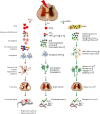Effects and Mechanisms of Acupuncture Combined with Mesenchymal Stem Cell Transplantation on Neural Recovery after Spinal Cord Injury: Progress and Prospects
- PMID: 33061954
- PMCID: PMC7533022
- DOI: 10.1155/2020/8890655
Effects and Mechanisms of Acupuncture Combined with Mesenchymal Stem Cell Transplantation on Neural Recovery after Spinal Cord Injury: Progress and Prospects
Abstract
Spinal cord injury (SCI) is a structural event with devastating consequences worldwide. Due to the limited intrinsic regenerative capacity of the spinal cord in adults, the neural restoration after SCI is difficult. Acupuncture is effective for SCI-induced neurologic deficits, and the potential mechanisms responsible for its effects involve neural protection by the inhibition of inflammation, oxidation, and apoptosis. Moreover, acupuncture promotes neural regeneration and axon sprouting by activating multiple cellular signal transduction pathways, such as the Wnt, Notch, and Rho/Rho kinase (ROCK) pathways. Several studies have demonstrated that the efficacy of combining acupuncture with mesenchymal stem cells (MSCs) transplantation is superior to either procedure alone. The advantage of the combined treatment is dependent on the ability of acupuncture to enhance the survival of MSCs, promote their differentiation into neurons, and facilitate targeted migration of MSCs to the spinal cord. Additionally, the differentiation of MSCs into neurons overcomes the problem of the shortage of endogenous neural stem cells (NSCs) in the acupuncture-treated SCI patients. Therefore, the combination of acupuncture and MSCs transplantation could become a novel and effective strategy for the treatment of SCI. Such a possibility needs to be verified by basic and clinical research.
Copyright © 2020 Huiling Tang et al.
Conflict of interest statement
The authors have no conflict of interest regarding this paper.
Figures

Similar articles
-
Electro-acupuncture and its combination with adult stem cell transplantation for spinal cord injury treatment: A summary of current laboratory findings and a review of literature.CNS Neurosci Ther. 2022 May;28(5):635-647. doi: 10.1111/cns.13813. Epub 2022 Feb 17. CNS Neurosci Ther. 2022. PMID: 35174644 Free PMC article. Review.
-
Co-Transplantation of Human Umbilical Cord Mesenchymal Stem Cells and Human Neural Stem Cells Improves the Outcome in Rats with Spinal Cord Injury.Cell Transplant. 2019 Jul;28(7):893-906. doi: 10.1177/0963689719844525. Epub 2019 Apr 23. Cell Transplant. 2019. PMID: 31012325 Free PMC article.
-
Electro-acupuncture promotes differentiation of mesenchymal stem cells, regeneration of nerve fibers and partial functional recovery after spinal cord injury.Exp Toxicol Pathol. 2011 Jan;63(1-2):151-6. doi: 10.1016/j.etp.2009.11.002. Epub 2009 Dec 16. Exp Toxicol Pathol. 2011. PMID: 20005688
-
Genetically modified mesenchymal stem cells (MSCs) promote axonal regeneration and prevent hypersensitivity after spinal cord injury.Exp Neurol. 2013 Oct;248:369-80. doi: 10.1016/j.expneurol.2013.06.028. Epub 2013 Jul 12. Exp Neurol. 2013. PMID: 23856436
-
A new combined therapeutic strategy of governor vessel electro-acupuncture and adult stem cell transplantation promotes the recovery of injured spinal cord.Curr Med Chem. 2011;18(33):5165-71. doi: 10.2174/092986711797636144. Curr Med Chem. 2011. PMID: 22050762 Review.
Cited by
-
Research Hotspots and Trends on Acupuncture for Anti-Inflammation: A Bibliometric Analysis from 2011 to 2021.J Pain Res. 2023 Apr 7;16:1197-1217. doi: 10.2147/JPR.S398393. eCollection 2023. J Pain Res. 2023. PMID: 37056280 Free PMC article.
-
Advances in novel biomaterials combined with traditional Chinese medicine rehabilitation technology in treatment of peripheral nerve injury.Front Neurol. 2024 Jun 13;15:1421772. doi: 10.3389/fneur.2024.1421772. eCollection 2024. Front Neurol. 2024. PMID: 38938781 Free PMC article. Review.
-
Electro-acupuncture and its combination with adult stem cell transplantation for spinal cord injury treatment: A summary of current laboratory findings and a review of literature.CNS Neurosci Ther. 2022 May;28(5):635-647. doi: 10.1111/cns.13813. Epub 2022 Feb 17. CNS Neurosci Ther. 2022. PMID: 35174644 Free PMC article. Review.
-
Dual-directional regulation of spinal cord injury and the gut microbiota.Neural Regen Res. 2024 Mar;19(3):548-556. doi: 10.4103/1673-5374.380881. Neural Regen Res. 2024. PMID: 37721283 Free PMC article. Review.
-
Global trends and hotspots in research on acupuncture for stroke: a bibliometric and visualization analysis.Eur J Med Res. 2023 Sep 21;28(1):359. doi: 10.1186/s40001-023-01253-w. Eur J Med Res. 2023. PMID: 37735698 Free PMC article.
References
-
- Nam K. Y., Kim H. J., Kwon B. S., Park J. W., Lee H. J., Yoo A. Robot-assisted gait training (Lokomat) improves walking function and activity in people with spinal cord injury: a systematic review. Journal of Neuroengineering and Rehabilitation. 2017;14(1):p. 24. doi: 10.1186/s12984-017-0232-3. - DOI - PMC - PubMed
Publication types
MeSH terms
LinkOut - more resources
Full Text Sources
Medical

